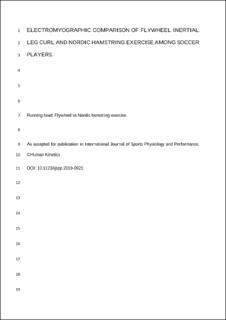Electromyographic Comparison of Flywheel Inertial Leg Curl and Nordic Hamstring Exercise Among Soccer Players
Peer reviewed, Journal article
Accepted version
Permanent lenke
https://hdl.handle.net/11250/2735690Utgivelsesdato
2020Metadata
Vis full innførselSamlinger
- Import fra CRIStin [3621]
- Institutt for idrett, kosthald og naturfag [1006]
Originalversjon
Pedersen, H., Sæterbakken, A. H., Vagle, M., Fimland, M. S., & Andersen, V. (2021). Electromyographic comparison of flywheel inertial leg curl and nordic hamstring exercise among soccer players. International Journal of Sports Physiology and Performance, 16(1), 97-102. 10.1123/ijspp.2019-0921Sammendrag
Purpose: The Nordic hamstring exercise (NHE) has been shown to considerably reduce hamstring injuries among soccer players. However, as the load in the NHE is the person’s own bodyweight, it is a very heavy exercise and difficult to individualize. The flywheel inertial leg curl (FLC) could be an alternative since the eccentric overload is based on the amount of work produced in the concentric movement. Therefore, the primary aim of this study was to compare the activation in the hamstrings at long muscle lengths in the NHE and the FLC in amateur soccer players. Methods: Fifteen male amateur soccer players performed 5 repetitions in each exercise in a randomized and counterbalanced order. The concentric and eccentric movements were divided into lower and upper phases. Surface EMG was measured distally, proximally, and in the middle, at both muscles. Results: In the lower phase in the eccentric movement, there were no significant differences between the 2 exercises (P = .101–.826). In the lower concentric movement, the FLC led to higher activation in all parts of both the biceps femoris (31%–52%, P < .001) and the semitendinosus (20%–35%, P = .001–.023). Conclusion: Both exercises activated the hamstrings similarly at long muscle lengths during eccentric contractions (Nordic hamstring, nonsignificantly higher). However, when performing concentric contractions, the FLC induced higher activations. Therefore, the FLC could be a useful alternative to the NHE and particularly suitable for weaker athletes before progressing to NHE.
Beskrivelse
Author accepted manuscript (postprint)
